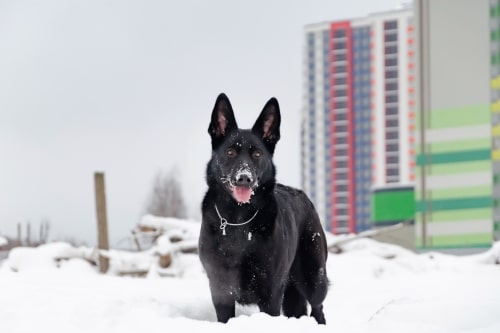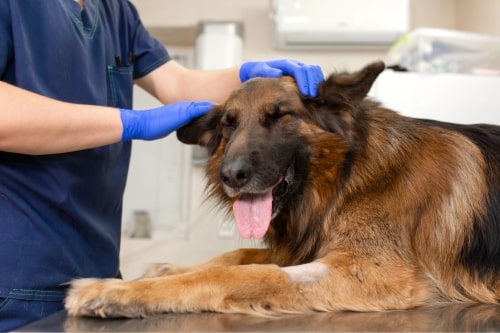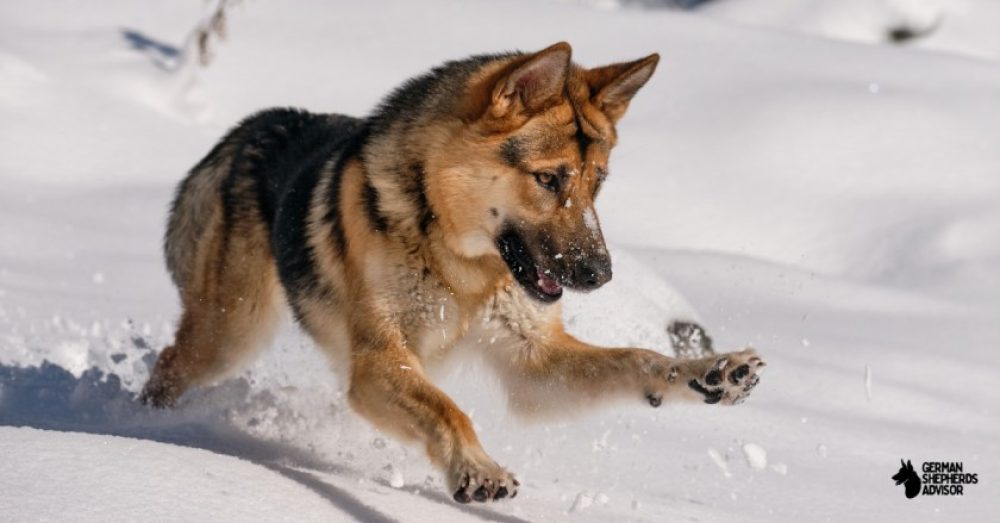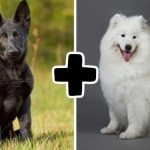There are a lot of big questions about German Shepherds that people have. One of the most common is if they get cold in winter like other breeds often do. To answer this question, we should look at what and how German Shepherds live and determine whether or not their bodies work differently than other dogs to create more heat.
German Shepherd dog breed information says they were first documented in 1899 and originated in Germany. They’re known for being strong working dogs and good with children, which makes them great family pets; what you might not know about German Shepherds is that they do tend to be very fluffy and big-boned.
They appear larger than other breeds. The breed was initially bred to be a herding dog, so they are purposely left with more meat on their bones. The German Shepherd’s body type works well for them to run swiftly, jump over high objects, and climb steep hills.
Thick fur coat to bear cold
They have thick fur coats designed to withstand harsh weather conditions. Their fur helps protect them from climate change, making them even less susceptible to extreme temperatures (Guide).
Another great fact about German Shepherds is that they pant very little compared to other dogs of their size. Panting is good because it cools down the body naturally by releasing heat through water vapor, but it can cause dehydration if not monitored carefully.
Their saliva contains no starch or sugar but has a high percentage of sodium, making it difficult to digest for other breeds, which is why they have a lower panting rate.
Do German Shepherds get cold in the wintertime?
The answer is no; German Shepherds do quite well in colder climates due to their thick fur coats and low panting rates. This doesn’t mean they can’t get cold if left outside for an extended period in extreme weather conditions, but they are better suited to colder temperatures than other breeds. Be sure to keep your GSD warm and comfortable in the winter by providing them with a nice dog coat or sweater and plenty of indoor relaxing space!
Do German shepherds prefer cold or hot?
Many breeds of dogs originated from a climate very different from their current living environment. In those days, they had to adapt to weather elements such as cold or heat without the protection of insulated buildings and heated vehicles. This may explain why some dogs still enjoy lying in the sun or under a shade tree despite air conditioning and ceiling fans at home.
Many animals sleep more during hot weather because they have less energy due to increased water needs and the fact that they are expending energy to keep cool.
The preferences of a German shepherd for hot or cold weather may depend on the individual dog’s metabolism, coat type, and exercise habits. Dogs with double coats (a thick outer coat and a thin inner coat) tend to resist cold weather better than dogs with single coats. Dogs that live in warm climates and have plenty of opportunities to exercise may not feel the need to sleep in cool weather.
German shepherds that live in cold climates and have little opportunity to exercise may prefer sleeping inside where it is warm. Some German shepherds may enjoy the challenge of staying warm in cold weather. No matter the reason, it is important to ensure your dog is protected from the cold and gains some heat from the sun.
The best way to do this is to provide a safe environment for outdoor sleeping:
- Keep the area clear of debris that can collect water and create a hazard, such as ice or excessive moisture, next to the house.
- Cover any areas where rainwater collects with gravel, wood chips, or decking material, such as plywood, so it doesn’t freeze and create a hazardous situation for your dog.
- Provide clean bedding on top of compacted snow or grass so your German shepherd does not have to lie on the bare ground, which may be frozen and uncomfortable under normal conditions.
- Remember that dogs prefer soft surfaces like grass to hard surfaces like asphalt or concrete.
In conclusion, your German shepherd’s preference for hot or cold weather may vary depending on the dog’s metabolism, coat type, and exercise habits.
It is important to provide a safe environment for outdoor sleeping by clearing away debris and covering wet areas to prevent hypothermia and other health problems. You can also provide a soft bedding surface like grass for your dog to sleep on.
Can German shepherds walk on snow?

Yes, German Shepherds can walk in snow. They have a thick fur coat that protects them from the cold weather. Their fur also helps keep them warm while walking in the snow. German Shepherds are very good at walking in the snow and can easily walk through deep snowdrifts.
They can also run and play in the snow without getting too cold. If you have a German Shepherd, take them for walks in the snow during the winter months. It will be a lot of fun for both of you!
German Shepherds were originally bred to work on farms in Germany. They were used to herd livestock, and their thick fur coat was perfect for keeping them warm in the cold weather. German Shepherds are also very good at guarding property and people.
They are loyal, protective dogs, and they make great pets. A German Shepherd may be the right choice if you are looking for a good dog in the snow. Ensure you provide your dog with plenty of warm clothing to wear in the winter months!
Ideal temperature for German shepherd puppy
When a German Shepherd puppy is in the breeder’s care, they are kept in an environment that will help to ensure proper health and growth. This can be anywhere from a clean house with lots of room for the puppies to play, or it could be something like this large industrial puppy farm. Ideally, you want your home to mimic life at its roots before they were even born to make the transition easier.
Here are some tips on how to take care of your GSD while he grows up:
Always keep water available for them because it aids digestion, helps keep the coat healthy, and opens airways if there is ever an attempt at vomiting. The key is freshness; don’t put out more than they can drink before it gets stale. Plus, stagnant water can create bacteria that will make your pup sick.
Don’t overfeed them! If you find yourself giving them food and they want more, step back and figure out what makes them hungry. They should be able to fill up one good meal every day. Of course, this could be two smaller meals if you prefer, but the key is freshness.
The biggest challenge for new GSD owners is housebreaking their dog or young puppy. Use positive reinforcement by rewarding him with cookies when he goes potty outside.
If you see him doing his business inside, then three methods work well:
- Clapping your hands loudly to startle them while they are going in the wrong place.
- Saying “NO!” in a loud, angry voice.
- Pouring a bucket of cold water over their head (this one is only for the most determined puppies!)

Whichever technique you choose, ensure you are consistent with it and that everyone living in the house is on the same page. Be patient; it could take up to two months before your pup is completely housebroken.
One more thing: keep an eye on their nails. As GSDs grow, their nails will, too – and if they’re not trimmed regularly, they can get pretty long, which makes it difficult for them too. You can take them to a groomer or learn how to do it yourself.
Here are some appropriate toys for your GSD pup to play with while he is growing up:
Kong – these can be stuffed with peanut butter, cheese or any kind of spreadable food that will make them work to get it all out. They are also made of rubber so they bounce around if you roll them on the floor. On top of all of this, Kongs can be frozen which makes for a longer-lasting treat/playtime!
Anything small and fluffy – GSDs love to carry around little squeaky toys and snuggle them when they lay down for a nap. It’s sorta adorable. A ball – because what dog doesn’t like playing catch?
Can German shepherds handle hot weather?
German shepherds are bred for work in various weather conditions to handle hot weather fairly well. However, you should still take precautions to keep your dog safe and comfortable during extreme heat waves. Ensure your German shepherd has plenty of water, and offer him shady areas to rest in.
If your dog seems uncomfortable or starts to pant excessively, take him inside to a cool place. And if you see any signs of heatstroke, seek emergency veterinary care. With some common sense, you can help keep your German shepherd safe and healthy during summer’s hottest days.
Extreme heat, like that which is often seen during summer, can drain your German shepherd’s energy and make him weak. If his body works too hard to cool off, he’ll get tired easily and even collapse after exercising or playing. During such times, walk him in the early morning or late evening when it is slightly cooler outside.
Play or exercise during the afternoon
Also, avoid letting him play too hard or exercise during the afternoon; always wear a doggy backpack with water bottles on hot days and let him drink from them regularly (he will be very grateful for ice cubes of freshwater).
If you live in an area with frequent high temperatures, consider building a doggy pool so he can jump into it anytime he wants to cool off. However, ensure the pool is in a shady area and that you keep an eye on him while he plays to check for signs of heatstroke.
Never tie your dog up outside during the summer months – if she’s left out in the sun without any shade or water, it can quickly cause heat exhaustion. Also, avoid walks during the hottest parts of the day (usually between 10:00 am and 2:00 pm), and never leave your dog unattended in a car. Even with windows cracked open, cars parked in direct sunlight can get hot enough inside to kill your German shepherd!
26 degree walk
Temperatures this low can cause severe health concerns, especially in breeds more susceptible to conditions such as hypothermia.







